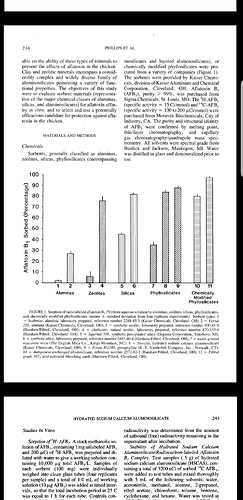But remember the spores aren’t the problem is the chemicals that the spores produce and killing the spores won’t get rid of what’s already there.
piva1995.pdf (701.1 KB)
What is acn
Acetonitrile.
Mold can happen after the grow is done. May have nothing to do with the grower.
If you are getting mold during the curing or drying process, you have issues and should not be growing.
That’s the least place I would expect mold issues.
10yrs+ growing, never any mold issues. Minus my myco colony that loves the top of my soil.
Do you test for mold?
Do you retest after long term storage?
Do you have a water activity meter?
Lots of people like weed really moist. Problem start around .65. I like to stay around .55.
Enzymatic degradation of alfatoxin is possible with an enzyme in Bacillus shackletonii L7 apparently. Novel Aflatoxin-Degrading Enzyme from Bacillus shackletonii L7 - PMC
This is a harebrained idea from someone who is just looking into building a lab, who is also learning this shit by the seat of his pants, so take it with a few grains of salt.
maybe introduce this bacteria to your sample, let the bacteria degrade the alfatoxin and then run the batch through .2 micron filter paper? that should render the sample sterile.
I don’t have any clue where to acquire or cultivate the bacteria, and this possibly could be insane, but none the less i felt it worth sharing
I spore test every other run .proper setup, and dry cure goes a long way.
E.coli strain also found with that capability. So enzymes could be scaled relatively easily.
Doesn’t seem to be available from ATCC, so you’ll have to ping the author
…so how do you get your cannabinoids into an aqueous solution?
Well the study specifies a methanol solution that is then diluted with water.
I wonder if the solution needs to be mostly water for the aflatoxin to bind to the media, like iif the adsorption of the aflatoxin is mainly dependent on water being present by catalyzing some chemical reaction on then surface of the media or if it just has to do with the polarity of the aqueous solution.
Either way it’s a start.
The likelihood of botrytis germinating on drying material decreases exponentially after 24 hours after harvest. Generally, the spores will begin germinating in late flower and continue to grow after harvest, especially if harvest/drying environmental conditions are not ideal. Sure, other types of mold could certainly grow on improperly dried flower in storage, however these should be elementary problems that any grower worth their weight should already know and be aware of. Over nitrogen fertilization is the primary cause of botrytis, and weak cell walls during the establishment period of growth is one of the main reasons for decreased shelf life of flower and rapid degradation and oxidation, which will increase susceptibility of botrytis. Really, after 24 hours post harvest, there should not be any worry of mold if things are done properly.
Here is an article linking over-fertilization of nitrogen to botrytis:
https://www.jstor.org/stable/41997911?seq=1#page_scan_tab_contents
Update: Got some results on distillate and crude that was made from remediated material, CO2 extracted. Testing in the ppb range, we had ND across the board for aflatoxins and ochratoxins.
interesting regarding too high of N levels… The only times I had bud rot was when I was running nutrients. I will admit I was very N happy back then and my plants didn’t like it. Since switching to soil feeding vs plant feeding, I haven’t had any signs of mold
nD on even the crude? That’s good to hear… ![]()
Yep, no data as far as other extraction solvents go, good news though.
Well now I’m wondering if it’s ever really worth it to make thc distillate lol. If my crude & filtering process can deal with it. I’m almost always happier with a decarbed thc cart with natural terps than distillate + added terps.
From:
“Strategies to prevent mycotoxin contamination of food and animal feed: a review.”
Kabak, Bulent; Dobson, Alan D W; Var, Işil; National Library of Medicine. Critical reviews in food science and nutrition Vol. 46, Iss. 8, (2006): 593-619.
“Several natural plant extract and spice oils of eugenol, cinnamon, oregano, onions, lemongrass, tumeric, mint, and chemical compounds (fungicide, herbicide, and surfectant) are known to prevent both mycotoxigenic mould growth and mycotoxin formation during post-harvest season…”
"Some adsorbents can bind and remove mycotoxins from aqueous solutions.20,171,187 Two extensively suggested mycotoxin binding agents are active charcoal and bentonite. The particle size of adsorbent and heat treatment have been reported to affect the degradation level of mycotoxins.188
Activated charcoal, at levels of 3-5 g 1^sup -1^ applied for 5 minutes have been shown to considerably decrease patulin levels in apple juice.189 Similarly Huebner et al.190 have reported that a composite carbon adsorbent in a fixed-bed adsorption system effectively reduced patulin levels in apple juice, although the appearance and task of the juice was affected, while Karadeniz and Eksi173 have reported the complete removal of 30 µg ml^sup -1^ of patulin from apple wine by active charcoal. In a similar study the patulin content of apple juice was decreased from 62.2 µg 1^sup -1^ to 30.8 µg 1^sup -1^ by the treatment with 3% activated charcoal for 5 min.187
In addition, bentonite has been shown to remove 65-79% of AFM^sub 1^ from milk,188 as well as up to nearly 100% of aflatoxins from liquid solution.24 While in another study by Kane et al.191 99% of AFB^sub 1^ was removed from peanut oil by adding clays such as attapulgite, kaolin, and novasil at 0.5 g 1^sup -1^."
Some terpenes will mitigate the presences of mycotoxins. Clays and AC will also bind many of these toxins. Seems like an issue that can be remediated with appropriate post-harvest treatment and if necessary, with chemical adsorption and/or treating with terpenes that are compatible with the health of consumers.

